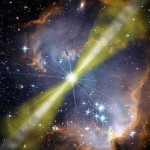69841197 Superluminal neutrinos have given hope to the explanation of the gamma ray bursts
Astronomers from France and Italy have found that the superluminal speed of muon neutrinos, the detector recorded OPERA, may explain the characteristic gamma-ray burst (GRB). Article scientists have not yet been published in peer-reviewed journal, but its preprint available at arXiv. org. As part of the scientists are considering several models of gamma-ray bursts – the most powerful astronomical events known at this time. One model assumes, for example, that the bursts – The result of rapid weight dialing a newborn black hole. In the framework of these models assume "production " a large number of high-energy neutrinos. These particles must be recorded by terrestrial observatories, but nothing like this happens. According to scientists, this means that any existing model of gamma-ray bursts are not true, either, as the results of OPERA, because neutrinos are moving faster than light, they arrived on Earth much earlier than expected time. The news of the unusual results of the collaboration OPERA, working with the same detector in the Italian National Laboratory in Gran Sasso, appeared September 23, 2011. According to physicists, neutrinos superprotonnom synchrotron at CERN, came to the detector earlier than predicted by the computer model. Data analysis revealed that the particles are moving at 0.00248 per cent faster than light. Information generated great interest among physicists. Thus, the site arXiv.org now appeared more than a dozen pre-prints on the results of the Italian detector. Physicists offer many explanations for the detected phenomena. Some believe the case to the group velocity, while others have found contradictions with observations of supernova SN 1987A (here and here). Several papers focused on the possible theoretical explanation of this phenomenon, in particular, violation of Lorentz invariance (here, here and here) and the presence of extra dimensions (here).
